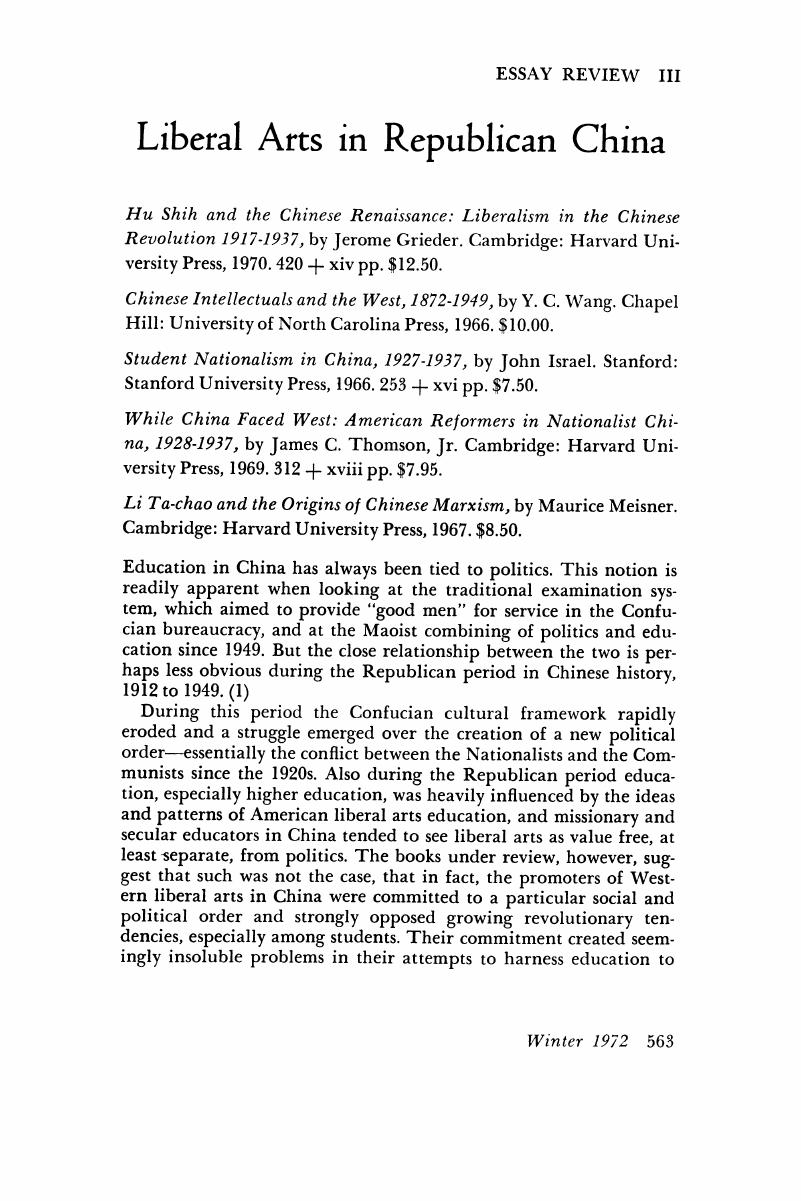No CrossRef data available.
Published online by Cambridge University Press: 24 February 2017

1. See: Peake, Cyrus H., Nationalism and Education in Modern China (New York, 1932).CrossRefGoogle Scholar
2. Wang, Y. C., Chinese Intellectuals and the West, 1872–1949 (Chapel Hill, 1966), pp. 499–500.Google Scholar
3. Grieder, Jerome, Hu Shih and the Chinese Renaissance: Liberalism in the Chinese Revolution, 1917–1937 (Cambridge, 1970), p. 70.Google Scholar
4. Ibid., p. 45.Google Scholar
5. Stuart, John Leighton, Fifty Years in China (New York, 1954), chapt. 10.Google Scholar
6. Shih, Hu, “Chang Poling: Educator,“ in There is Another China (New York, 1948), p. 14.Google Scholar
7. Djung, Lu-dzai, History of Democratic Education in Modern China (Shanghai, 1934), p. 74.Google Scholar
8. Ibid., p. 225.Google Scholar
9. Lindbeck, John M. H., “The Organization and Development of Science,“ in China Under Mao: Politics Takes Command, ed. MacFarquar, Roderick (Cambridge, 1966), pp. 362–63.Google Scholar
10. Lindbeck, John M. H., Understanding China: An Assessment of American Scholarly Resources (New York, 1971), p. 18.Google Scholar
11. In this regard Gregory, Jessie Lutz's comprehensive study, China and the Christian Colleges, 1850–1950 (Ithaca, 1971), goes far beyond the essentially missionary oriented studies of each of the Christian colleges, produced by the United Board for Christian Higher Education in Asia (New York) in the 1950s and 1960s: Scott, Roderick, Fukien Christian University: A Historical Sketch (1954); Lamberton, Mary, St. John's University Shanghai, 1879–1951 (1955); Corbett, Charles Hodge, Shantung Christian University (Cheeloo) (1955) Day, Clarence Burton, Hangchow University: A Brief History (1955); Thurston, Mrs. Lawrence (Pt. I) and Chester, Ruth M. Miss (Pt. II), Ginling College (1955); Wallace, L. Ethel, Hwa Nan College: The Woman's College of South China (1955); Nance, W. B., Soochow University (1956); Edwards, Dwight W., Yenching University; Coe, John L., Huachung University (1961).Google Scholar
12. Wang, , Chinese Intellectuals, p. xiii.Google Scholar
13. Ch'üan-kuo kao-teng chia-yü t'ung-chi (Nanking, 1932).Google Scholar
14. Wang, , Chinese Intellectuals, p. 169.Google Scholar
15. Ibid., pp. 374–77.Google Scholar
16. Ibid., p. 371.Google Scholar
17. Ibid., pp. 174–87.Google Scholar
18. Ibid., p. 374.Google Scholar
19. Ibid., p. 377.Google Scholar
20. Ibid., pp. 394–95.Google Scholar
21. Ibid., p. 400. See also Grieder, , Hu Shih, pp. 91–96.Google Scholar
22. Thomson, James C. Jr., While China Faced West: American Reformers in Nationalist China, 1928–1937 (Cambridge, 1969), p. 203.Google Scholar
23. Ibid., p. 204.Google Scholar
24. Israel, John, Student Nationalism in China, 1927–1937 (Stanford, 1966), p. 185.Google Scholar
25. Ibid.Google Scholar
26. Ibid., p. 186.Google Scholar
27. Schneider, Lawrence A., Ku Chieh-kang and China's New History: Nationalism and the Quest for Alternative Traditions (Berkeley, 1971), p. 124. Schneider's book is an insightful study into the increasing role of the masses in shaping the identity of Chinese intellectuals in the Republican period.Google Scholar
28. Meisner, Maurice, Li Ta-chao and the Origins of Chinese Marxism (Cambridge, 1967), p. 107.Google Scholar
29. Ibid.Google Scholar
30. Ibid., pp. 105–6.Google Scholar
31. Ibid., p. 107.Google Scholar
32. Ibid., pp. 107–8.Google Scholar